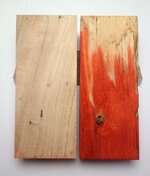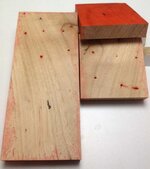MesquiteMan
Retired Head Moderator
In a previous thread, this question was contentiously raised so I thought I would start a new thread with results from a recent test I did.
Not sure what kind of destructive testing to do but here is a stain test for what it is worth.
Two blocks of spalted pecan 3"x3"x5" +/- from the same log right next to each other were chosen for this test. The block on the left was stabilized first while the block on the right was natural. Water was dyed orange and the blocks were stood on end in 1" of the dyed water for 4 hours. Once taken from the water, they were dried off and each was cut in half length wise. The stabilized blank had MINOR absorption of the orange water about 1/6" of an inch on the end grain. The unstabilized block had dye penetration about 80% up the blank.

Next, one half of the stabilized block was dropped in the water/dye mix and sank to the bottom right away. It was allowed to soak for 24 hours, completely submerged. It was then removed, dried off, and cut in half length wise and then cross cut. The piece on the left is the full length portion and the pic on the right shows the outside of one half and the inside of the other. The orange dots you see are bug holes that went all the way through the wood and since this resin is not designed to fill cracks or holes, the dye flowed through.

Link me the destructive testing and the stain test on this setup please.
Not sure what kind of destructive testing to do but here is a stain test for what it is worth.
Two blocks of spalted pecan 3"x3"x5" +/- from the same log right next to each other were chosen for this test. The block on the left was stabilized first while the block on the right was natural. Water was dyed orange and the blocks were stood on end in 1" of the dyed water for 4 hours. Once taken from the water, they were dried off and each was cut in half length wise. The stabilized blank had MINOR absorption of the orange water about 1/6" of an inch on the end grain. The unstabilized block had dye penetration about 80% up the blank.
Next, one half of the stabilized block was dropped in the water/dye mix and sank to the bottom right away. It was allowed to soak for 24 hours, completely submerged. It was then removed, dried off, and cut in half length wise and then cross cut. The piece on the left is the full length portion and the pic on the right shows the outside of one half and the inside of the other. The orange dots you see are bug holes that went all the way through the wood and since this resin is not designed to fill cracks or holes, the dye flowed through.
Attachments
Last edited:



